Analysis of Telstra's 2017 Financial Performance: Corporate Accounting
VerifiedAdded on 2021/06/14
|6
|1075
|24
Report
AI Summary
This report analyzes Telstra's financial performance in 2017, focusing on key elements such as total income, net profit after tax, shareholder returns, and dividend payments. It examines events after the reporting date, highlighting that no significant events occurred besides the final dividend payment. The report details changes in accounting policies, referencing amendments to AASB standards regarding acquisitions, depreciation, annual improvements, disclosure, and scope. Additionally, it outlines the carrying amounts of Telstra's property, plant, and equipment, including land, buildings, communication assets, and other equipment. The analysis is supported by references to Telstra's annual reports and relevant accounting standards.
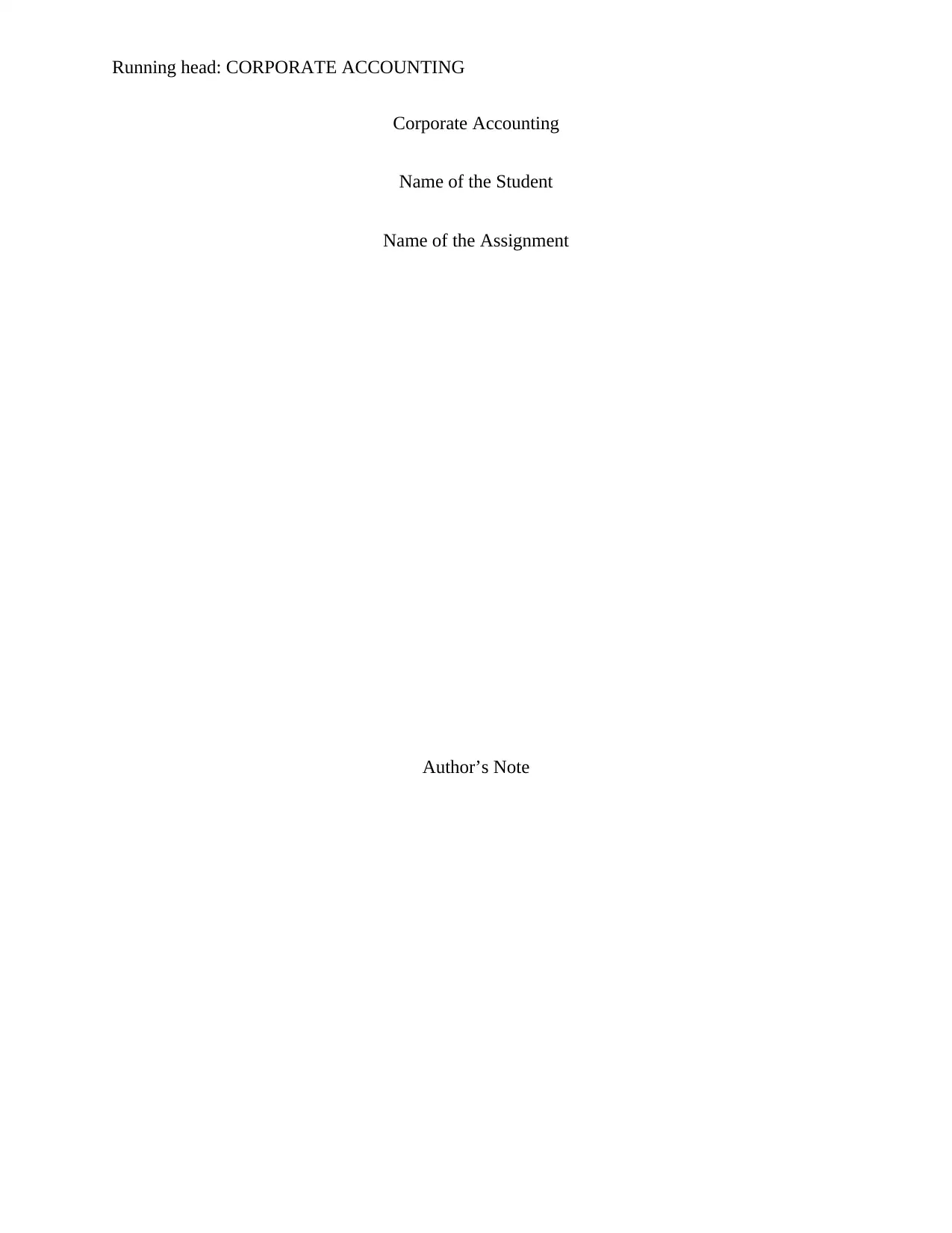
Running head: CORPORATE ACCOUNTING
Corporate Accounting
Name of the Student
Name of the Assignment
Author’s Note
Corporate Accounting
Name of the Student
Name of the Assignment
Author’s Note
Paraphrase This Document
Need a fresh take? Get an instant paraphrase of this document with our AI Paraphraser
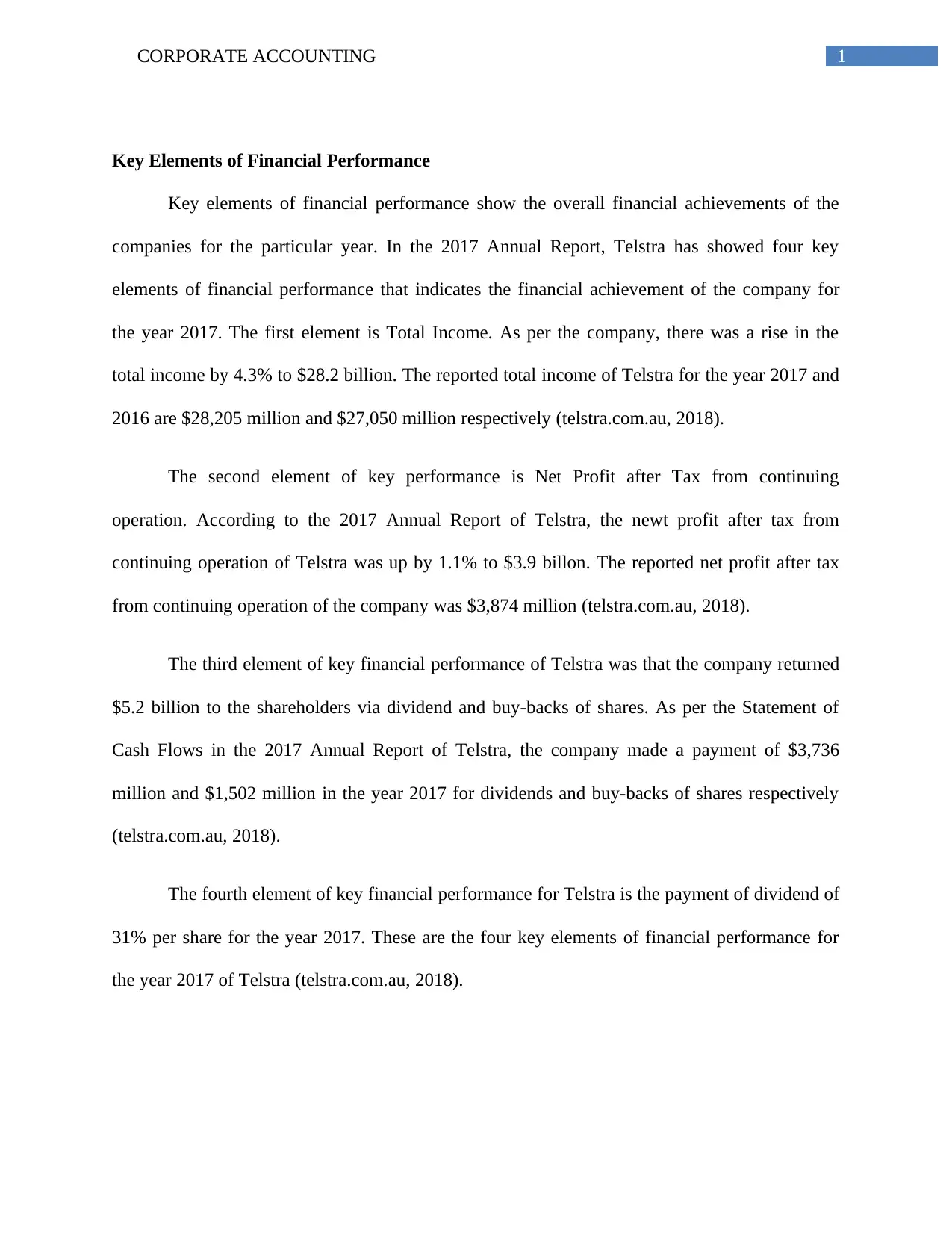
1CORPORATE ACCOUNTING
Key Elements of Financial Performance
Key elements of financial performance show the overall financial achievements of the
companies for the particular year. In the 2017 Annual Report, Telstra has showed four key
elements of financial performance that indicates the financial achievement of the company for
the year 2017. The first element is Total Income. As per the company, there was a rise in the
total income by 4.3% to $28.2 billion. The reported total income of Telstra for the year 2017 and
2016 are $28,205 million and $27,050 million respectively (telstra.com.au, 2018).
The second element of key performance is Net Profit after Tax from continuing
operation. According to the 2017 Annual Report of Telstra, the newt profit after tax from
continuing operation of Telstra was up by 1.1% to $3.9 billon. The reported net profit after tax
from continuing operation of the company was $3,874 million (telstra.com.au, 2018).
The third element of key financial performance of Telstra was that the company returned
$5.2 billion to the shareholders via dividend and buy-backs of shares. As per the Statement of
Cash Flows in the 2017 Annual Report of Telstra, the company made a payment of $3,736
million and $1,502 million in the year 2017 for dividends and buy-backs of shares respectively
(telstra.com.au, 2018).
The fourth element of key financial performance for Telstra is the payment of dividend of
31% per share for the year 2017. These are the four key elements of financial performance for
the year 2017 of Telstra (telstra.com.au, 2018).
Key Elements of Financial Performance
Key elements of financial performance show the overall financial achievements of the
companies for the particular year. In the 2017 Annual Report, Telstra has showed four key
elements of financial performance that indicates the financial achievement of the company for
the year 2017. The first element is Total Income. As per the company, there was a rise in the
total income by 4.3% to $28.2 billion. The reported total income of Telstra for the year 2017 and
2016 are $28,205 million and $27,050 million respectively (telstra.com.au, 2018).
The second element of key performance is Net Profit after Tax from continuing
operation. According to the 2017 Annual Report of Telstra, the newt profit after tax from
continuing operation of Telstra was up by 1.1% to $3.9 billon. The reported net profit after tax
from continuing operation of the company was $3,874 million (telstra.com.au, 2018).
The third element of key financial performance of Telstra was that the company returned
$5.2 billion to the shareholders via dividend and buy-backs of shares. As per the Statement of
Cash Flows in the 2017 Annual Report of Telstra, the company made a payment of $3,736
million and $1,502 million in the year 2017 for dividends and buy-backs of shares respectively
(telstra.com.au, 2018).
The fourth element of key financial performance for Telstra is the payment of dividend of
31% per share for the year 2017. These are the four key elements of financial performance for
the year 2017 of Telstra (telstra.com.au, 2018).
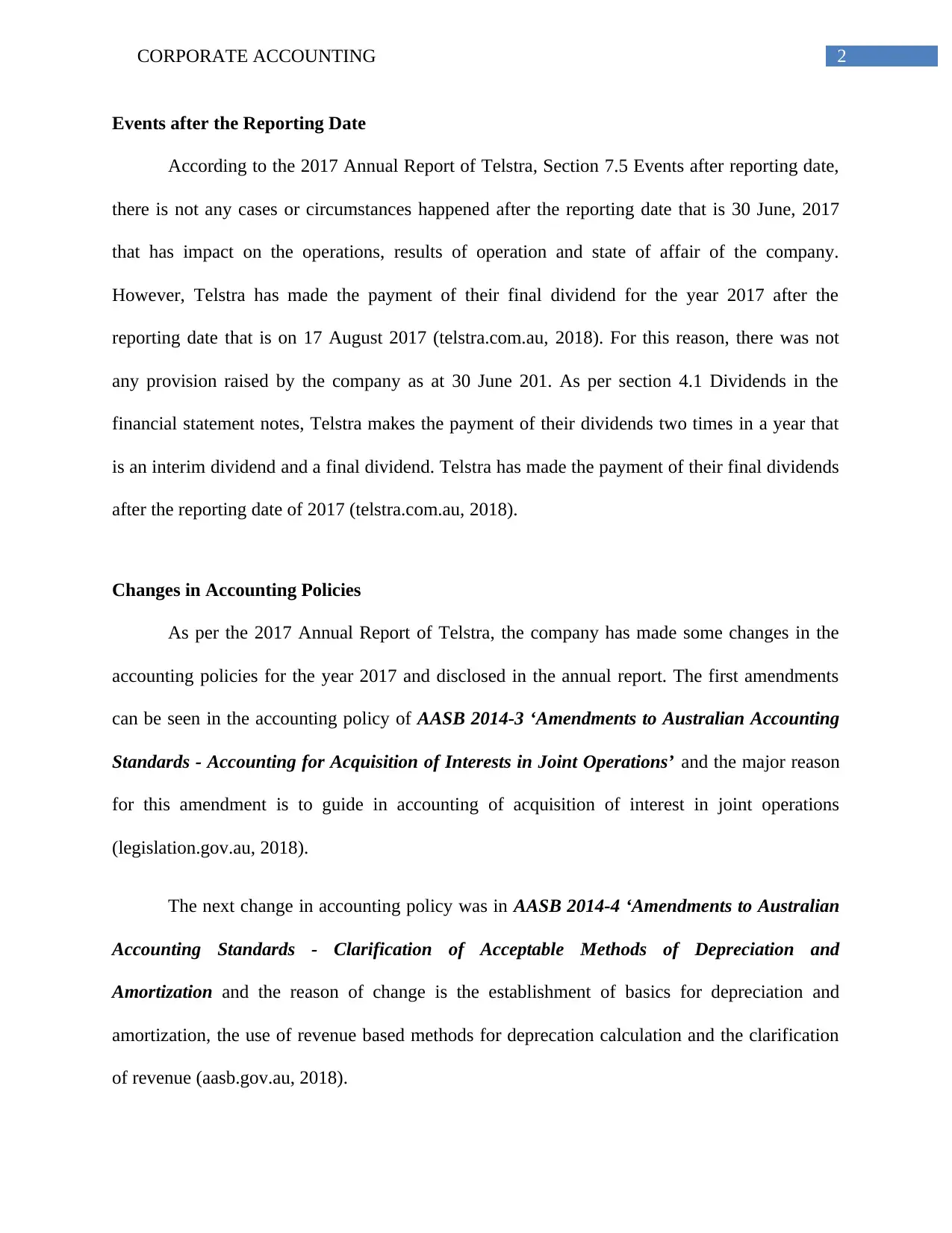
2CORPORATE ACCOUNTING
Events after the Reporting Date
According to the 2017 Annual Report of Telstra, Section 7.5 Events after reporting date,
there is not any cases or circumstances happened after the reporting date that is 30 June, 2017
that has impact on the operations, results of operation and state of affair of the company.
However, Telstra has made the payment of their final dividend for the year 2017 after the
reporting date that is on 17 August 2017 (telstra.com.au, 2018). For this reason, there was not
any provision raised by the company as at 30 June 201. As per section 4.1 Dividends in the
financial statement notes, Telstra makes the payment of their dividends two times in a year that
is an interim dividend and a final dividend. Telstra has made the payment of their final dividends
after the reporting date of 2017 (telstra.com.au, 2018).
Changes in Accounting Policies
As per the 2017 Annual Report of Telstra, the company has made some changes in the
accounting policies for the year 2017 and disclosed in the annual report. The first amendments
can be seen in the accounting policy of AASB 2014-3 ‘Amendments to Australian Accounting
Standards - Accounting for Acquisition of Interests in Joint Operations’ and the major reason
for this amendment is to guide in accounting of acquisition of interest in joint operations
(legislation.gov.au, 2018).
The next change in accounting policy was in AASB 2014-4 ‘Amendments to Australian
Accounting Standards - Clarification of Acceptable Methods of Depreciation and
Amortization and the reason of change is the establishment of basics for depreciation and
amortization, the use of revenue based methods for deprecation calculation and the clarification
of revenue (aasb.gov.au, 2018).
Events after the Reporting Date
According to the 2017 Annual Report of Telstra, Section 7.5 Events after reporting date,
there is not any cases or circumstances happened after the reporting date that is 30 June, 2017
that has impact on the operations, results of operation and state of affair of the company.
However, Telstra has made the payment of their final dividend for the year 2017 after the
reporting date that is on 17 August 2017 (telstra.com.au, 2018). For this reason, there was not
any provision raised by the company as at 30 June 201. As per section 4.1 Dividends in the
financial statement notes, Telstra makes the payment of their dividends two times in a year that
is an interim dividend and a final dividend. Telstra has made the payment of their final dividends
after the reporting date of 2017 (telstra.com.au, 2018).
Changes in Accounting Policies
As per the 2017 Annual Report of Telstra, the company has made some changes in the
accounting policies for the year 2017 and disclosed in the annual report. The first amendments
can be seen in the accounting policy of AASB 2014-3 ‘Amendments to Australian Accounting
Standards - Accounting for Acquisition of Interests in Joint Operations’ and the major reason
for this amendment is to guide in accounting of acquisition of interest in joint operations
(legislation.gov.au, 2018).
The next change in accounting policy was in AASB 2014-4 ‘Amendments to Australian
Accounting Standards - Clarification of Acceptable Methods of Depreciation and
Amortization and the reason of change is the establishment of basics for depreciation and
amortization, the use of revenue based methods for deprecation calculation and the clarification
of revenue (aasb.gov.au, 2018).
⊘ This is a preview!⊘
Do you want full access?
Subscribe today to unlock all pages.

Trusted by 1+ million students worldwide
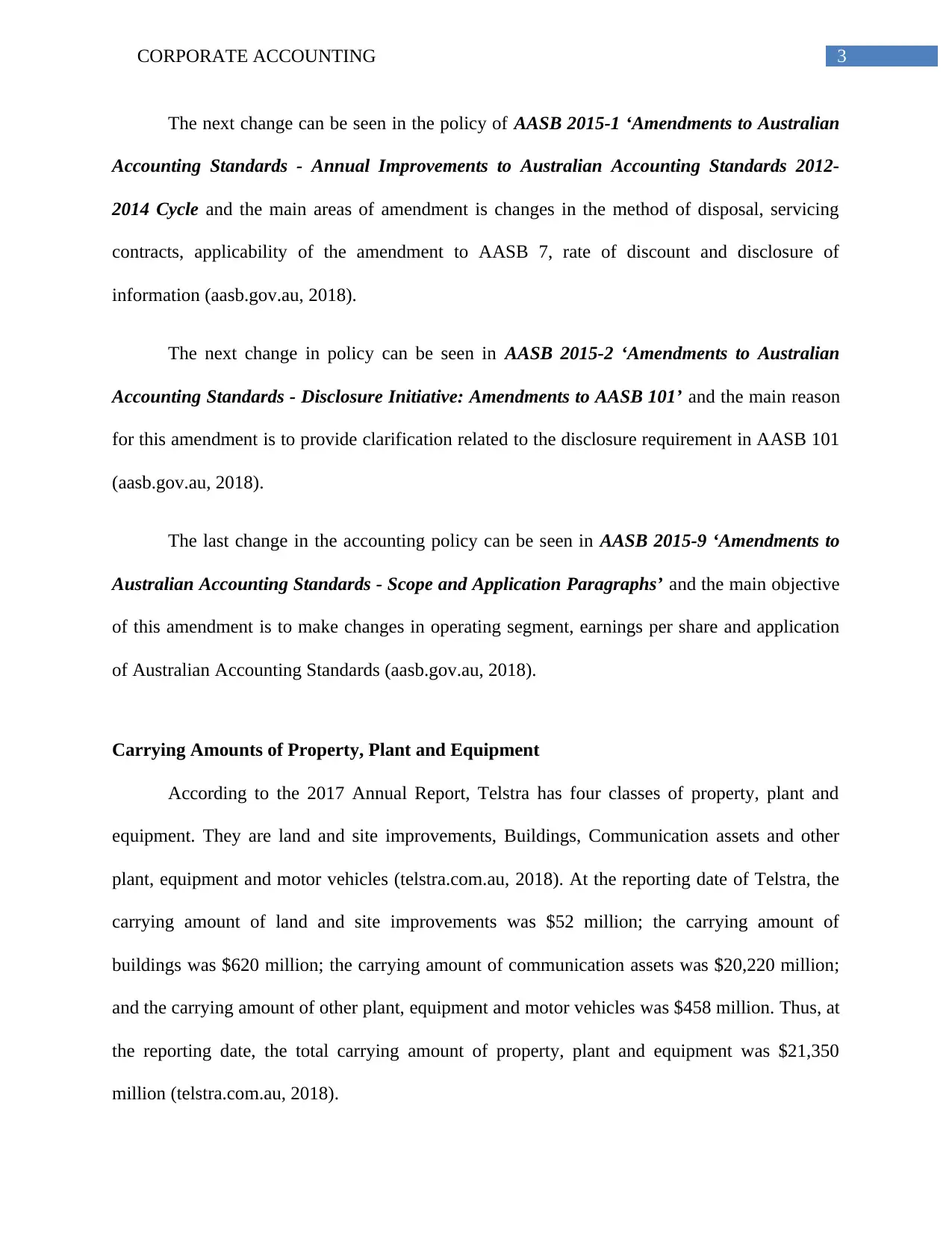
3CORPORATE ACCOUNTING
The next change can be seen in the policy of AASB 2015-1 ‘Amendments to Australian
Accounting Standards - Annual Improvements to Australian Accounting Standards 2012-
2014 Cycle and the main areas of amendment is changes in the method of disposal, servicing
contracts, applicability of the amendment to AASB 7, rate of discount and disclosure of
information (aasb.gov.au, 2018).
The next change in policy can be seen in AASB 2015-2 ‘Amendments to Australian
Accounting Standards - Disclosure Initiative: Amendments to AASB 101’ and the main reason
for this amendment is to provide clarification related to the disclosure requirement in AASB 101
(aasb.gov.au, 2018).
The last change in the accounting policy can be seen in AASB 2015-9 ‘Amendments to
Australian Accounting Standards - Scope and Application Paragraphs’ and the main objective
of this amendment is to make changes in operating segment, earnings per share and application
of Australian Accounting Standards (aasb.gov.au, 2018).
Carrying Amounts of Property, Plant and Equipment
According to the 2017 Annual Report, Telstra has four classes of property, plant and
equipment. They are land and site improvements, Buildings, Communication assets and other
plant, equipment and motor vehicles (telstra.com.au, 2018). At the reporting date of Telstra, the
carrying amount of land and site improvements was $52 million; the carrying amount of
buildings was $620 million; the carrying amount of communication assets was $20,220 million;
and the carrying amount of other plant, equipment and motor vehicles was $458 million. Thus, at
the reporting date, the total carrying amount of property, plant and equipment was $21,350
million (telstra.com.au, 2018).
The next change can be seen in the policy of AASB 2015-1 ‘Amendments to Australian
Accounting Standards - Annual Improvements to Australian Accounting Standards 2012-
2014 Cycle and the main areas of amendment is changes in the method of disposal, servicing
contracts, applicability of the amendment to AASB 7, rate of discount and disclosure of
information (aasb.gov.au, 2018).
The next change in policy can be seen in AASB 2015-2 ‘Amendments to Australian
Accounting Standards - Disclosure Initiative: Amendments to AASB 101’ and the main reason
for this amendment is to provide clarification related to the disclosure requirement in AASB 101
(aasb.gov.au, 2018).
The last change in the accounting policy can be seen in AASB 2015-9 ‘Amendments to
Australian Accounting Standards - Scope and Application Paragraphs’ and the main objective
of this amendment is to make changes in operating segment, earnings per share and application
of Australian Accounting Standards (aasb.gov.au, 2018).
Carrying Amounts of Property, Plant and Equipment
According to the 2017 Annual Report, Telstra has four classes of property, plant and
equipment. They are land and site improvements, Buildings, Communication assets and other
plant, equipment and motor vehicles (telstra.com.au, 2018). At the reporting date of Telstra, the
carrying amount of land and site improvements was $52 million; the carrying amount of
buildings was $620 million; the carrying amount of communication assets was $20,220 million;
and the carrying amount of other plant, equipment and motor vehicles was $458 million. Thus, at
the reporting date, the total carrying amount of property, plant and equipment was $21,350
million (telstra.com.au, 2018).
Paraphrase This Document
Need a fresh take? Get an instant paraphrase of this document with our AI Paraphraser

4CORPORATE ACCOUNTING
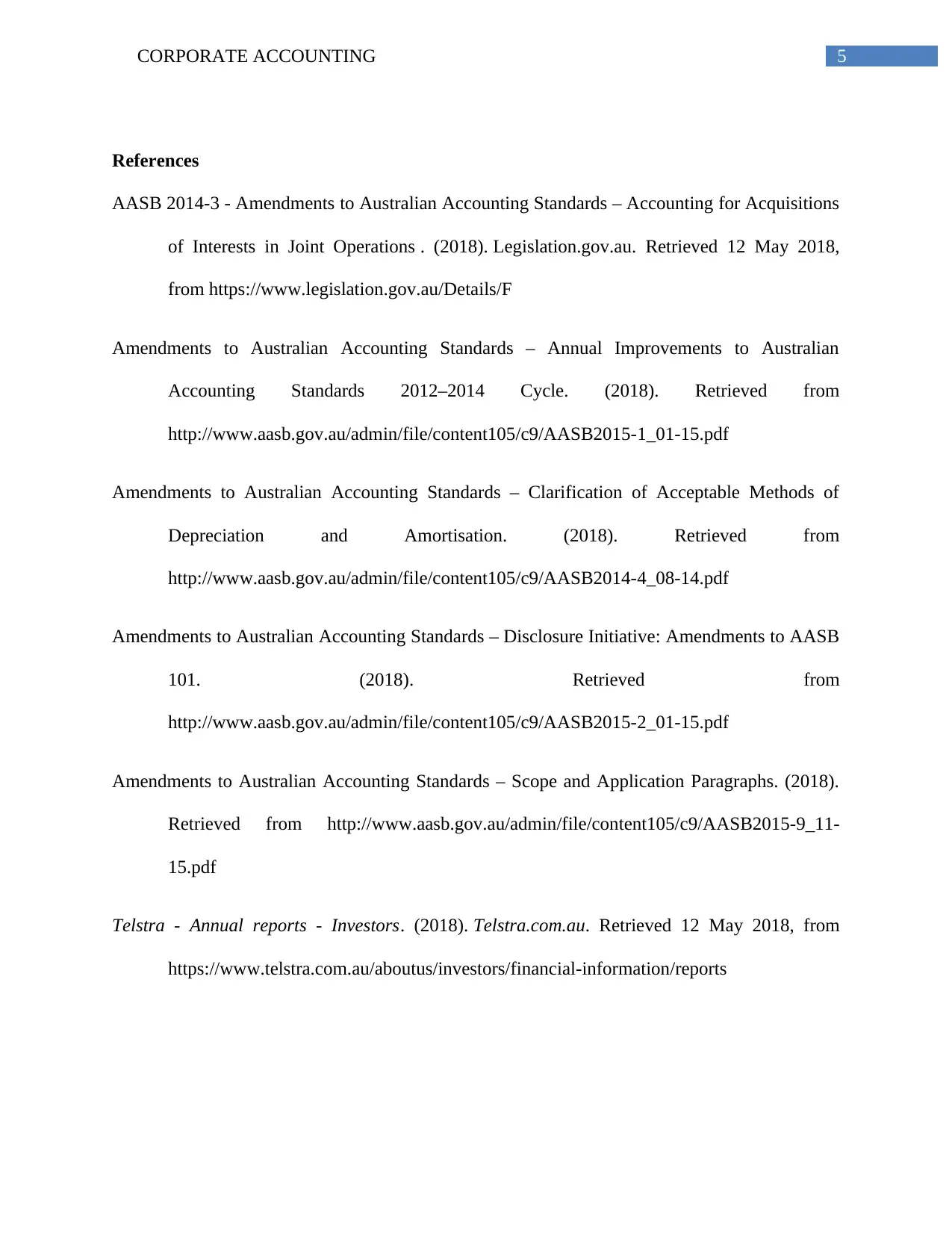
5CORPORATE ACCOUNTING
References
AASB 2014-3 - Amendments to Australian Accounting Standards – Accounting for Acquisitions
of Interests in Joint Operations . (2018). Legislation.gov.au. Retrieved 12 May 2018,
from https://www.legislation.gov.au/Details/F
Amendments to Australian Accounting Standards – Annual Improvements to Australian
Accounting Standards 2012–2014 Cycle. (2018). Retrieved from
http://www.aasb.gov.au/admin/file/content105/c9/AASB2015-1_01-15.pdf
Amendments to Australian Accounting Standards – Clarification of Acceptable Methods of
Depreciation and Amortisation. (2018). Retrieved from
http://www.aasb.gov.au/admin/file/content105/c9/AASB2014-4_08-14.pdf
Amendments to Australian Accounting Standards – Disclosure Initiative: Amendments to AASB
101. (2018). Retrieved from
http://www.aasb.gov.au/admin/file/content105/c9/AASB2015-2_01-15.pdf
Amendments to Australian Accounting Standards – Scope and Application Paragraphs. (2018).
Retrieved from http://www.aasb.gov.au/admin/file/content105/c9/AASB2015-9_11-
15.pdf
Telstra - Annual reports - Investors. (2018). Telstra.com.au. Retrieved 12 May 2018, from
https://www.telstra.com.au/aboutus/investors/financial-information/reports
References
AASB 2014-3 - Amendments to Australian Accounting Standards – Accounting for Acquisitions
of Interests in Joint Operations . (2018). Legislation.gov.au. Retrieved 12 May 2018,
from https://www.legislation.gov.au/Details/F
Amendments to Australian Accounting Standards – Annual Improvements to Australian
Accounting Standards 2012–2014 Cycle. (2018). Retrieved from
http://www.aasb.gov.au/admin/file/content105/c9/AASB2015-1_01-15.pdf
Amendments to Australian Accounting Standards – Clarification of Acceptable Methods of
Depreciation and Amortisation. (2018). Retrieved from
http://www.aasb.gov.au/admin/file/content105/c9/AASB2014-4_08-14.pdf
Amendments to Australian Accounting Standards – Disclosure Initiative: Amendments to AASB
101. (2018). Retrieved from
http://www.aasb.gov.au/admin/file/content105/c9/AASB2015-2_01-15.pdf
Amendments to Australian Accounting Standards – Scope and Application Paragraphs. (2018).
Retrieved from http://www.aasb.gov.au/admin/file/content105/c9/AASB2015-9_11-
15.pdf
Telstra - Annual reports - Investors. (2018). Telstra.com.au. Retrieved 12 May 2018, from
https://www.telstra.com.au/aboutus/investors/financial-information/reports
⊘ This is a preview!⊘
Do you want full access?
Subscribe today to unlock all pages.

Trusted by 1+ million students worldwide
1 out of 6
Related Documents
Your All-in-One AI-Powered Toolkit for Academic Success.
+13062052269
info@desklib.com
Available 24*7 on WhatsApp / Email
![[object Object]](/_next/static/media/star-bottom.7253800d.svg)
Unlock your academic potential
Copyright © 2020–2025 A2Z Services. All Rights Reserved. Developed and managed by ZUCOL.





